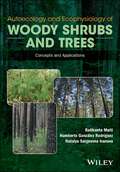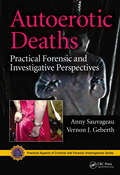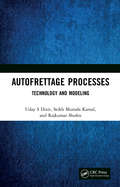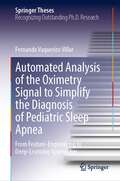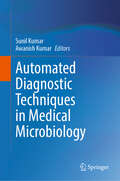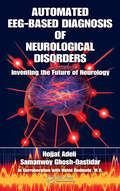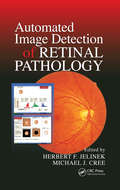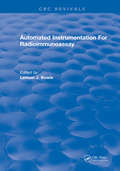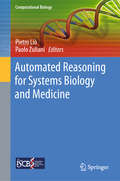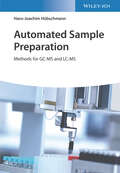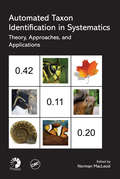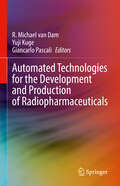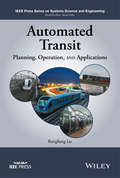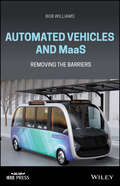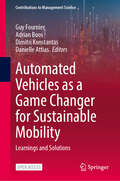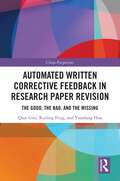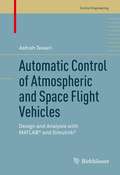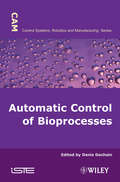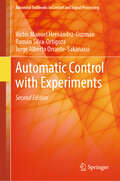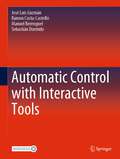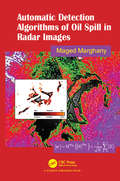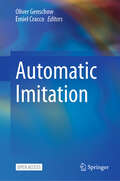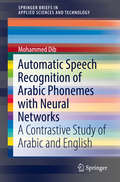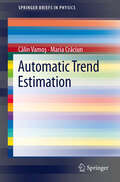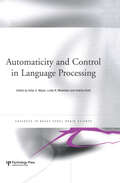- Table View
- List View
Autoecology and Ecophysiology of Woody Shrubs and Trees: Concepts and Applications
by Ratikanta Maiti Humbero Gonzalez Rodriguez Natalya Sergeevna IvanovaForest trees and shrubs play vital ecological roles, reducing the carbon load from the atmosphere by using carbon dioxide in photosynthesis and by the storage of carbon in biomass and wood as a source of energy. Autoecology deals with all aspects of woody plants; the dynamism of populations, physiological traits of trees, light requirements, life history patterns, and physiological and morphological characters. Ecophysiology is defined by various plant growth parameters such as leaf traits, xylem water potential, plant height, basal diameter, and crown architecture which are, in turn, influenced by physiological traits and environmental conditions in the forest ecosystem. In short, this book details research advances in various aspects of woody plants to help forest scientists and foresters manage and protect forest trees and plan their future research. Autoecology and Ecophysiology of Woody Shrubs and Trees is intended to be a guide for students of woody plant autoecology and ecophysiology, as well as for researchers in this field. It is also an invaluable resource for foresters to assist in effective management of forest resources.
Autoerotic Deaths: Practical Forensic and Investigative Perspectives (ISSN)
by Anny Sauvageau Vernon J. GeberthA collaboration between two internationally known experts, this volume presents a scientific, modern view of autoerotic death, complete with a variety of case histories and investigator tips. Enhanced with more than 100 color photos, the book begins by exploring the evolution of the concept of sexual asphyxia and autoerotic death. It then examines death scene characteristics and the importance of recognizing clues to the autoerotic nature of a death. Using a case history format to describe methods as well as typical and atypical victims, the book is an unparalleled resource for all those involved in the investigation of these peculiar incidents.
Autofrettage Processes: Technology and Modelling
by Rajkumar Shufen Uday Dixit Seikh KamalAutofrettage Processes: Technology and Modeling deals with the technology and modeling of autofrettage processes, explaining the subject in a lucid manner. It highlights how the theory of plasticity and finite element modeling are applied in the modeling of autofrettage processes. Aimed at senior students of mechanical, production, automobile, and chemical engineering, it has the potential to directly benefit practicing engineers and industrials, owing to the inclusion of topics like thermal autofrettage. Key Features: Provides a general introduction to autofrettage Covers the application of theory of plasticity and finite element modeling of autofrettage processes Offers exposure to newer autofrettage processes that to date have not been implemented in industries, along with useful practical data
Automated Analysis of the Oximetry Signal to Simplify the Diagnosis of Pediatric Sleep Apnea: From Feature-Engineering to Deep-Learning Approaches (Springer Theses)
by Fernando Vaquerizo VillarThis book describes the application of novel signal processing algorithms to improve the diagnostic capability of the blood oxygen saturation signal (SpO2) from nocturnal oximetry in the simplification of pediatric obstructive sleep apnea (OSA) diagnosis. For this purpose, 3196 SpO2 recordings from three different databases were analyzed using feature-engineering and deep-learning methodologies. Particularly, three novel feature extraction algorithms (bispectrum, wavelet, and detrended fluctuation analysis), as well as a novel deep-learning architecture based on convolutional neural networks are proposed. The proposed feature-engineering and deep-learning models outperformed conventional features from the oximetry signal, as well as state-of-the-art approaches. On the one hand, this book shows that bispectrum, wavelet, and detrended fluctuation analysis can be used to characterize changes in the SpO2 signal caused by apneic events in pediatric subjects. On the other hand, it demonstrates that deep-learning algorithms can learn complex features from oximetry dynamics that allow to enhance the diagnostic capability of nocturnal oximetry in the context of childhood OSA. All in all, this book offers a comprehensive and timely guide to the use of signal processing and AI methods in the diagnosis of pediatric OSA, including novel methodological insights concerning the automated analysis of the oximetry signal. It also discusses some open questions for future research.
Automated Diagnostic Techniques in Medical Microbiology
by Sunil Kumar Awanish KumarThis book will explore the knowledge of current diagnostic automation techniques applied in the field of clinical microbiology, tropical diseases, POCT, etc. There is no such type of book related to this topic. This book will help clinicians, microbiologists, and researchers to make diagnostic algorithms for infectious diseases and help them in early diagnosis. Automation in clinical microbiology has revolutionized routine practice in diagnostic cum research in medical microbiology. This book covers the recent updates and advances in diagnostic microbiology and provides new techniques related to Genomic, Proteomic, and metabolomics in microbiology. This book will intensely discuss the new and innovative automation techniques available for diagnosis in the microbiology laboratory. This book is more focused on automation techniques, which are used in the early detection of infectious diseases even caused by rare microorganisms. Furthermore, this book has complied with the chapters that provide insights to readers with comprehensive and usable knowledge on automation techniques in diagnostic microbiology.
Automated EEG-Based Diagnosis of Neurological Disorders: Inventing the Future of Neurology
by Hojjat Adeli Samanwoy Ghosh-DastidarBased on the authors' groundbreaking research, Automated EEG-Based Diagnosis of Neurological Disorders: Inventing the Future of Neurology presents a research ideology, a novel multi-paradigm methodology, and advanced computational models for the automated EEG-based diagnosis of neurological disorders. It is based on the ingenious integration of thr
Automated Image Detection of Retinal Pathology
by Herbert Jelinek Michael J. CreeDiscusses the Effect of Automated Assessment Programs on Health Care ProvisionDiabetes is approaching pandemic numbers, and as an associated complication, diabetic retinopathy is also on the rise. Much about the computer-based diagnosis of this intricate illness has been discovered and proven effective in research labs. But, unfortunately, many of
Automated Instrumentation For Radioimmunoassay
by Lemuel J. BowieThe various instruments described in this text all provide an integrated and automated approach for separating free and bound ligands along with other steps in radioimmunoassay. Although the various systems differ significantly in design, they all perform these basic manoeuvres, for the most part, without any operator intervention. It is hoped that the following descriptions of the various system capabilities will not only provide useful information for present and potential users of the systems, but also stimulate additional development by manufacturers which will bring the full potential of radioimmunoassay even closer to a reality.
Automated Reasoning for Systems Biology and Medicine (Computational Biology #30)
by Pietro Liò Paolo ZulianiThis book presents outstanding contributions in an exciting, new and multidisciplinary research area: the application of formal, automated reasoning techniques to analyse complex models in systems biology and systems medicine. Automated reasoning is a field of computer science devoted to the development of algorithms that yield trustworthy answers, providing a basis of sound logical reasoning. For example, in the semiconductor industry formal verification is instrumental to ensuring that chip designs are free of defects (or “bugs”). Over the past 15 years, systems biology and systems medicine have been introduced in an attempt to understand the enormous complexity of life from a computational point of view. This has generated a wealth of new knowledge in the form of computational models, whose staggering complexity makes manual analysis methods infeasible. Sound, trusted, and automated means of analysing the models are thus required in order to be able to trust their conclusions. Above all, this is crucial to engineering safe biomedical devices and to reducing our reliance on wet-lab experiments and clinical trials, which will in turn produce lower economic and societal costs. Some examples of the questions addressed here include: Can we automatically adjust medications for patients with multiple chronic conditions? Can we verify that an artificial pancreas system delivers insulin in a way that ensures Type 1 diabetic patients never suffer from hyperglycaemia or hypoglycaemia? And lastly, can we predict what kind of mutations a cancer cell is likely to undergo? This book brings together leading researchers from a number of highly interdisciplinary areas, including: · Parameter inference from time series · Model selection · Network structure identification · Machine learning · Systems medicine · Hypothesis generation from experimental data · Systems biology, systems medicine, and digital pathology · Verification of biomedical devices “This book presents a comprehensive spectrum of model-focused analysis techniques for biological systems ...an essential resource for tracking the developments of a fast moving field that promises to revolutionize biology and medicine by the automated analysis of models and data.”Prof Luca Cardelli FRS, University of Oxford
Automated Sample Preparation: Methods for GC-MS and LC-MS
by Hans-Joachim HubschmannAn essential guide to the proven automated sample preparation process While the measurement step in sample preparation is automated, the sample handling step is manual and all too often open to risk and errors. The manual process is of concern for accessing data quality as well as producing limited reproducibility and comparability. Handbook of Automated Sample Preparation for CG-MS and LC-MS explores the advantages of implementing automated sample preparation during the handling phase for CG-MS and LC-MS. The author, a noted expert on the topic, includes information on the proven workflows that can be put in place for many routine and regulated analytical methods. This book offers a guide to automated workflows for both on-line and off-line sample preparation. This process has proven to deliver consistent and comparable data quality, increased sample amounts, and improved cost efficiency. In addition, the process follows Standard Operation Procedures that are essential for audited laboratories. This important book: Provides the information and tools needed for the implementation of instrumental sample preparation workflows Offers proven and detailed examples that can be adapted in analytical laboratories Shows how automated sample preparation can reduce cost per sample, increase sample amounts, and produce faster results Includes illustrative examples from various fields such as chemistry to food safety and pharmaceuticals Written for personnel in analytical industry, pharmaceutical, and medical laboratories, Handbook of Automated Sample Preparation for CG-MS and LC-MS offers the much-needed tools for implementing the automated sample preparation for analytical laboratories.
Automated Taxon Identification in Systematics: Theory, Approaches and Applications
by Norman MacLeodThe automated identification of biological objects or groups has been a dream among taxonomists and systematists for centuries. However, progress in designing and implementing practical systems for fully automated taxon identification has been frustratingly slow. Regardless, the dream has never died. Recent developments in computer architectures an
Automated Technologies for the Development and Production of Radiopharmaceuticals
by Yuji Kuge R. Michael van Dam Giancarlo PascaliThis is the first comprehensive book about the advanced technologies used in the radiopharmaceutical field. It covers each major area of radiopharmaceutical preparation, including radioisotope production and separation, multi-step radiosynthesis, analysis and quality control of the products as well as technologies for novel radiopharmaceutical development. Chapters are written by leaders in the field and comprehensively describe the evolution of relevant technologies, the current state-of-the-art, and future directions. The book will be an invaluable tool for researchers in radiochemistry or radiopharmaceutical development, disease researchers, and pharmaceutical researchers developing new drugs using in vivo imaging techniques in the drug development process.
Automated Transit: Planning, Operation, and Applications
by Rongfang LiuA comprehensive discussion of automated transit This book analyzes the successful implementations of automated transit in various international locations, such as Paris, Toronto, London, and Kuala Lumpur, and investigates the apparent lack of automated transit applications in the urban environment in the United States. The book begins with a brief definition of automated transit and its historical development. After a thorough description of the technical specifications, the author highlights a few applications from each sub-group of the automated transit spectrum. International case studies display various technologies and their applications, and identify vital factors that affect each system and performance evaluations of existing applications. The book then discusses the planning and operation of automated transit applications at both macro and micro levels. Finally, the book covers a number of less successful concepts, as well as the lessons learned, allowing readers to gain a comprehensive understanding of the topic. Key features: Provides a thorough examination of automated transit applications, their impact and implications for society Written by the committee chair for the Automated Transit Systems Transportation, Research Board Offers essential information on planning, costs, and applications of automated transit systems Covers driverless metros, automated LRT, group and personal rapid transit, a review of worldwide applications Includes capacity and safety guidelines, as well as vehicles, propulsion, and communication and control systems This book is essential reading for engineers, researchers, scientists, college or graduate students who work in transportation planning, engineering, operation and management fields. Dr. Rongfang Liu is a transportation professor in the Department of Civil and Environmental Engineering, New Jersey Institute of Technology (NJIT). Dr. Liu's research interests include Intermodal and Multimodal Transportation Planning and Engineering, Operation Research and Network Simulations, and transportation safety performance analyses. Dr. Liu is actively participating in various professional organizations and service activities. Since 2008, she has been the Chair of AP040 Committee: Automated Transit Systems, Transportation Research Board, and National Academy of Science. She was also the President of NACOTA (2006-2008), a federally registered non-profit organization for Chinese Overseas Transportation Professionals. Dr. Liu has authored and edited eight books, published more than 30 referred journal papers and book chapters, and made more than a hundred presentations in the transportation field. She is a registered professional engineer (PE) as well as a certified planner (AICP).
Automated Vehicles and MaaS: Removing the Barriers (Wiley - IEEE)
by Bob WilliamsAUTOMATED VEHICLES AND MaaS A topical overview of the issues facing automated driving systems and Mobility as a Service, identifies the obstacles to implementation and offers potential solutionsAdvances in cooperative and automated vehicle (CAV) technologies, cultural and socio-economic shifts, measures to combat climate change, social pressures to reduce road deaths and injuries, and changing attitudes toward self-driving cars, are creating new and exciting mobility scenarios worldwide. However, many obstacles remain and are compounded by the consequences of COVID-19. Mobility as a Service (MaaS) integrates various forms of public and private transport services into a single on-demand mobility service. Combining trains, cars, buses, bicycles, and other forms of transport, MaaS promises a convenient, cost-effective, and eco-friendly alternative to private automobiles.Automated Vehicles and MaaS: Removing the Barriers is an up-to-date overview of the contemporary challenges facing CAVs and MaaS. Written in a clear and accessible style, this timely volume summarizes recent research studies, describes the evolution of automated driving systems and MaaS, identifies the barriers to their widespread adoption, and proposes potential solutions to overcome and remove these barriers. The text focuses on the claims, realities, politics, new organizational roles, and implementation problems associated with CAVs and MaaS—providing industry professionals, policymakers, planners, administrators, and investors with a clear understanding of the issues facing the introduction of automated driving systems and MaaS. This important guide and reference:Provides an overview of recent progress, the current state of the art, and discussion of future objectivesPresents both technical background and general overview of automated driving systems and MaaSCovers political, commercial, and practical issues, as well as technical and research content, yet suitable for non-specialistsHelps readers make informed decisions and realistic estimates for implementing mobility solutions and new business models for transport servicesIncludes an extensive bibliography with direct links to in-depth technical engineering and research informationAutomated Vehicles and MaaS: Removing the Barriers is an essential resource for transport providers, vehicle manufacturers, urban and transport planners, students of transportation, vehicle technology, and urban planning, and transport policy and strategy managers, advisors, and reviewers.
Automated Vehicles as a Game Changer for Sustainable Mobility: Learnings and Solutions (Contributions to Management Science)
by Danielle Attias Adrian Boos Dimitri Konstantas Guy FournierThis open access book explores a vision for a sustainable future in urban mobility through the AVENUE project, showcasing full-scale demonstrations of automated minibuses in European cities. AVENUE pioneers on-demand, door-to-door services, challenging traditional fixed bus itineraries. It delves into the implementation of automated vehicles, emphasizing safety, services, cybersecurity, and accessibility. Part two evaluates the economic, environmental, and social impacts on companies, citizens, and cities. By integrating automated vehicles into Mobility-as-a-Service and Intelligent Transport Systems, the book argues for the using of automated vehicles as game changer towards a transformative shift to sustainable, citizen-centric mobility. It advocates for efficiency, flexibility, and resilience of the transport system without imposing coercive transformation policies.
Automated Written Corrective Feedback in Research Paper Revision: The Good, The Bad, and The Missing (China Perspectives)
by Qian Guo Ruiling Feng Yuanfang HuaThis book studies the use of an automated writing evaluation (AWE) systems in research paper revision for publication purposes by Chinese doctoral students.Research writing skills are essential for achieving academic status, and AWE tools can be a great companion on the journey. However, AWE tools may provide a disservice if users do not stay alert to inaccurate feedback, inaccurate correction suggestions, and missed errors. The effects of accurate feedback on revision outcomes have been the focus of a number of AWE studies, but student engagement and revision results in cases of inaccurate feedback and missed errors have rarely been investigated. Such investigations can provide practical advice on using automated feedback in research writing. This book provides a comprehensive evaluation of AWE tools and profiles student engagement with tool use in cases of different qualities of feedback. It can empower novice scholars and improve the effectiveness of academic writing instructors. The findings can also inform AWE system developers about possible ways of system improvement for research paper writing.The book will be particularly useful to students and scholars of language and linguistic studies, education, and academic English writing.
Automatic Control of Atmospheric and Space Flight Vehicles: Design and Analysis with MATLAB® and Simulink® (Control Engineering)
by Ashish TewariAutomatic Control of Atmospheric and Space Flight Vehicles is perhaps the first book on the market to present a unified and straightforward study of the design and analysis of automatic control systems for both atmospheric and space flight vehicles. Covering basic control theory and design concepts, it is meant as a textbook for senior undergraduate and graduate students in modern courses on flight control systems. In addition to the basics of flight control, this book covers a number of upper-level topics and will therefore be of interest not only to advanced students, but also to researchers and practitioners in aeronautical engineering, applied mathematics, and systems/control theory.
Automatic Control of Bioprocesses
by Denis DochainGiving an overview of the challenges in the control of bioprocesses, this comprehensive book presents key results in various fields, including: dynamic modeling; dynamic properties of bioprocess models; software sensors designed for the on-line estimation of parameters and state variables; control and supervision of bioprocesses.
Automatic Control with Experiments (Advanced Textbooks in Control and Signal Processing)
by Ramón Silva-Ortigoza Victor Manuel Hernández-Guzmán Jorge Alberto Orrante-SakanassiThis book offers an enhanced and comprehensive understanding of control theory and its practical applications. The theoretical chapters on control tools have been meticulously revised and improved to provide a clearer and more insightful exploration of the fundamental concepts and ideas. The explanations have been refined, and new examples have been added to aid comprehension. Additionally, a new chapter on discrete-time systems has been included, delving into an important aspect of control theory. Advanced topics in control are also covered in greater detail, ensuring a comprehensive treatment of the subject matter. The section on experimental applications has been revamped to showcase the application of control ideas in various scenarios. Several chapters have been replaced with fresh content that focuses on controlling new and different experimental prototypes. These examples illustrate how control concepts can be effectively applied in real-world situations. Furthermore,this book introduces a new approach for control of non-minimum phase systems and explores the concept of differential flatness for multiple-input multiple-output systems. Additionally, a fascinating application involving a wheeled pendulum mobile robot has been included. While some chapters have been replaced, the second edition retains the chapters on the control of DC motors and the control of a magnetic levitation system. However, the material in the former chapter is mostly new, and the latter chapter is entirely supported by new control concepts and ideas.
Automatic Control with Interactive Tools
by Manuel Berenguel José Luis Guzmán Ramon Costa-Castelló Sebastián DormidoAutomatic Control with Interactive Tools is a textbook for undergraduate study of automatic control. Providing a clear course structure, and covering concepts taught in engineering degrees, this book is an ideal companion to those studying or teaching automatic control. The authors have used this text successfully to teach their students.By providing unique interactive tools, which have been designed to illustrate the most important automatic control concepts, Automatic Control with Interactive Tools helps students overcome the potential barriers presented by the significant mathematical content of automatic control courses. Even when they have previously had only the benefit of an introductory control course, the software tools presented will help readers to get to grips with the use of such techniques as differential equations, linear algebra, and differential geometry. This textbook covers the breadth of automatic control topics, including time responses of dynamic systems, the Nyquist criterion and PID control. It switches smoothly between analytical and practical approaches. Automatic Control with Interactive Tools offers a clear introduction to automatic control, ideal for undergraduate students, instructors and anyone wishing to familiarize themselves with the fundamentals of the subject
Automatic Detection Algorithms of Oil Spill in Radar Images
by Maged MarghanySynthetic Aperture Radar Automatic Detection Algorithms (SARADA) for Oil Spills conveys the pivotal tool required to fully comprehend the advanced algorithms in radar monitoring and detection of oil spills, particularly quantum computing and algorithms as a keystone to comprehending theories and algorithms behind radar imaging and detection of marine pollution. Bridging the gap between modern quantum mechanics and computing detection algorithms of oil spills, this book contains precise theories and techniques for automatic identification of oil spills from SAR measurements. Based on modern quantum physics, the book also includes the novel theory on radar imaging mechanism of oil spills. With the use of precise quantum simulation of trajectory movements of oil spills using a sequence of radar images, this book demonstrates the use of SARADA for contamination by oil spills as a promising novel technique. Key Features: Introduces basic concepts of a radar remote sensing. Fills a gap in the knowledge base of quantum theory and microwave remote sensing. Discusses the important aspects of oil spill imaging in radar data in relation to the quantum theory. Provides recent developments and progresses of automatic detection algorithms of oil spill from radar data. Presents 2-D oil spill radar data in 4-D images.
Automatic Imitation
by Oliver Genschow Emiel CraccoPeople spontaneously imitate a wide range of different behaviors. The interest in this phenomenon dates back to at least the 18th century when Adam Smith (1759) argued that imitation can be seen as a primitive form of sympathy. Despite the longstanding interest, it was not until the 20th century that different research fields within psychology and neuroscience started empirically investigating this social phenomenon. This book brings together leading researchers from various domains to provide readers with a recent overview of developments in automatic imitation research. This is an open access book.
Automatic Speech Recognition of Arabic Phonemes with Neural Networks: A Contrastive Study of Arabic and English (SpringerBriefs in Applied Sciences and Technology)
by Mohammed DibThis book presents a contrastive linguistics study of Arabic and English for the dual purposes of improved language teaching and speech processing of Arabic via spectral analysis and neural networks. Contrastive linguistics is a field of linguistics which aims to compare the linguistic systems of two or more languages in order to ease the tasks of teaching, learning, and translation. The main focus of the present study is to treat the Arabic minimal syllable automatically to facilitate automatic speech processing in Arabic. It represents important reading for language learners and for linguists with an interest in Arabic and computational approaches.
Automatic trend estimation (SpringerBriefs in Physics)
by Maria Cr˘aciun C˘alin Vamos¸Our book introduces a method to evaluate the accuracy of trend estimation algorithms under conditions similar to those encountered in real time series processing. This method is based on Monte Carlo experiments with artificial time series numerically generated by an original algorithm. The second part of the book contains several automatic algorithms for trend estimation and time series partitioning. The source codes of the computer programs implementing these original automatic algorithms are given in the appendix and will be freely available on the web. The book contains clear statement of the conditions and the approximations under which the algorithms work, as well as the proper interpretation of their results. We illustrate the functioning of the analyzed algorithms by processing time series from astrophysics, finance, biophysics, and paleoclimatology. The numerical experiment method extensively used in our book is already in common use in computational and statistical physics.
Automaticity and Control in Language Processing (Advances in Behavioural Brain Science)
by Antje S. Meyer Linda R. Wheeldon Andrea KrottThe use of language is a fundamental component of much of our day-to-day life. Language often co-occurs with other activities with which it must be coordinated. This raises the question of whether the cognitive processes involved in planning spoken utterances and in understanding them are autonomous or whether they are affected by, and perhaps affect, non-linguistic cognitive processes, with which they might share processing resources. This question is the central concern of Automaticity and Control in Language Processing. The chapters address key issues concerning the relationship between linguistic and non-linguistic processes, including: How can the degree of automaticity of a component be defined? Which linguistic processes are truly automatic, and which require processing capacity? Through which mechanisms can control processes affect linguistic performance? How might these mechanisms be represented in the brain? How do limitations in working memory and executive control capacity affect linguistic performance and language re-learning in persons with brain damage? This important collection from leading international researchers will be of great interest to researchers and students in the area.
